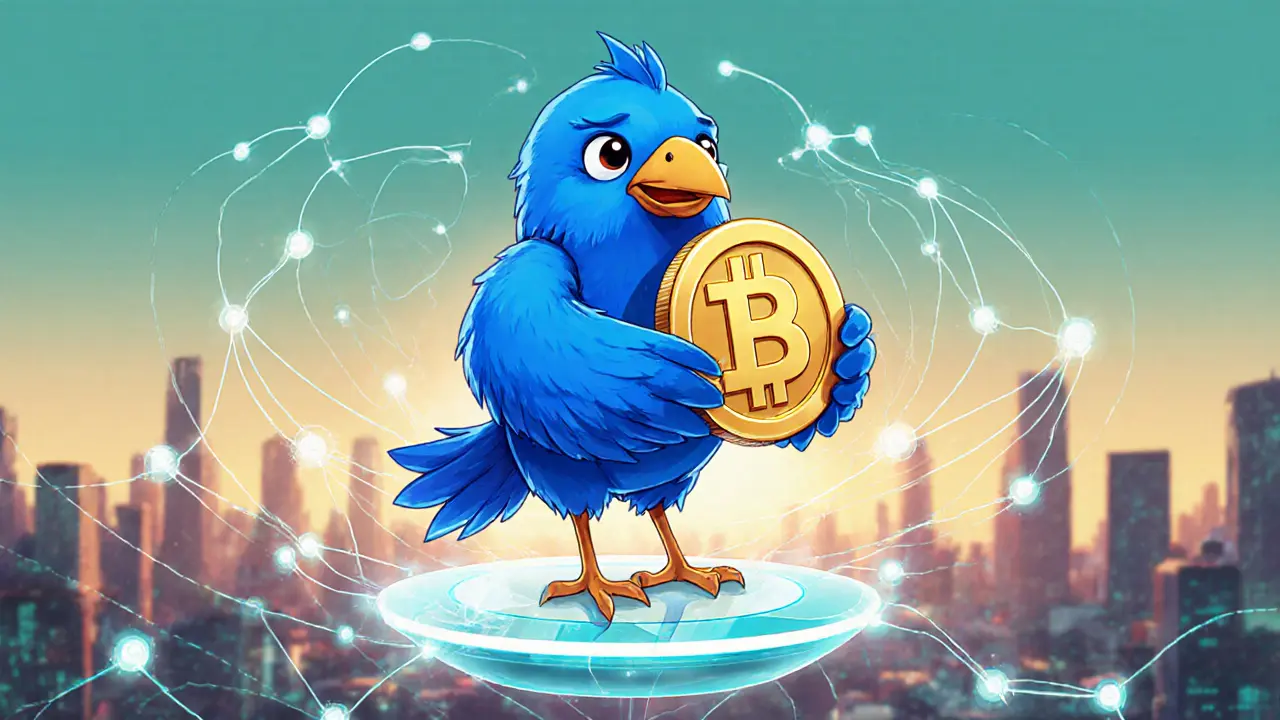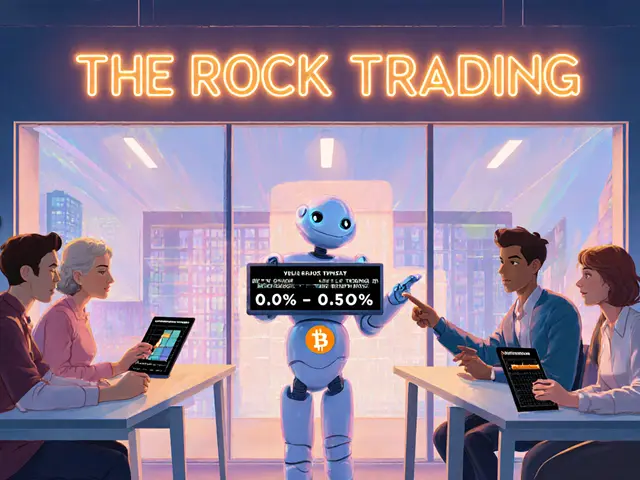BIRD Airdrop Eligibility Calculator
Airdrop Requirements
To qualify for Bird Finance's airdrop, you must:
- Hold at least 10 BIRD tokens OR $50 USDC equivalent at snapshot
- Connect wallet and complete social verification
- Meet all requirements before final snapshot
Current BIRD Token Price
Eligibility Check
Critical Risk Warning
Remember: Meeting token requirements doesn't guarantee eligibility. Scammers often mimic Bird Finance - always verify:
- Contract address on Etherscan
- Official Twitter verification
- SSL certificate on airdrop site
If you’ve seen headlines about a Bird Finance airdrop and wonder whether it’s worth your time, this guide breaks down everything you need to know - from token mechanics to eligibility rules and the red flags you should watch for.
What is Bird Finance?
Bird Finance is a decentralized finance (DeFi) platform that offers a "smart pool" system to automatically chase the highest‑yield mining pools across multiple blockchains. The protocol also provides lending services, NFT‑based rewards, and a community‑governed DAO that decides which pools to integrate. Launched in early 2024, Bird Finance markets itself as a one‑click yield‑optimiser, bundling staking, auto‑compounding, and token rewards into a single flow.
How does the BIRD token work?
The native governance token, BIRD, powers the ecosystem. Its tokenomics are hyper‑deflationary: half of the total supply was sent to a black‑hole address at launch, creating permanent scarcity. Every BIRD transaction incurs a 6% fee, split as follows:
- 2% to the liquidity pool on decentralized exchanges.
- 2% to the DAO governance pool for voting and development funds.
- 2% redistributed proportionally to existing BIRD holders.
Because the black‑hole holds the largest chunk, each transaction burns more tokens, applying upward price pressure while simultaneously rewarding holders.
Airdrop Overview & Timeline
Bird Finance announced an airdrop to boost early adoption, but the schedule has been fluid. Initial communications pointed to a November302024 listing, later pushed to Q12025. As of October2025, the airdrop has either been executed with limited public data or postponed again. The confusion stems from three similarly‑named projects (Birdchain, the "Birds" Sui game, and Bird Finance) all using the BIRD symbol.
Eligibility & Participation Steps
To qualify for the Bird Finance airdrop, participants typically needed to complete three layers of verification:
- Connect a compatible crypto wallet (MetaMask, Phantom, or Trust Wallet) to the official airdrop portal.
- Engage with Bird Finance’s official social channels - follow Twitter, join the Telegram group, and retweet the announcement.
- Hold a minimum amount of BIRD or designated partner tokens (e.g., $10BIRD or $50 worth of USDC) at the snapshot date.
After the wallet connection, the platform records a proof‑of‑participation hash, then distributes tokens proportionally to qualifying addresses.
How Bird Finance’s Airdrop Stacks Up Against Similar BIRD Drops
| Project | Token Symbol | Eligibility Criteria | Distribution Method | Notable Risks |
|---|---|---|---|---|
| Bird Finance | BIRD | Wallet connection + social actions + $10 BIRD holding | Direct contract airdrop to verified wallets | Timeline ambiguity, token‑omics complexity |
| Birdchain | BIRD | Follow Twitter, join Telegram, submit bot‑generated form | Batch transfer via centralized script | Potential phishing bots, no DAO involvement |
| Birds (Sui game) | BIRD | Reach level10 in‑game, link Sui wallet | In‑game claim UI | Game‑centric, limited liquidity, cross‑chain bridge risk |
Bird Finance’s airdrop stands out for its governance tie‑in - recipients automatically become DAO participants - but it also carries the most regulatory and technical uncertainty.
Key Risks & Red Flags
Before you click ‘Claim’, consider these pitfalls:
- Token volatility: BIRD’s price can swing dramatically after each airdrop batch.
- Regulatory ambiguity: Deflationary tokens are under increasing scrutiny in several jurisdictions.
- Smart‑contract exposure: Audits for Bird Finance’s smart‑pool contracts are sparse, raising security concerns.
- Name confusion: Scammers may impersonate Bird Finance by mimicking its logo or using similar URLs.
- Liquidity pressure: The 2% liquidity‑pool fee can thin market depth on smaller DEXes.

How to Verify Authenticity
Follow this checklist to ensure you’re dealing with the real Bird Finance airdrop:
- Check the contract address on Etherscan (or the appropriate explorer for Solana/HECO). The official address is listed on Bird Finance’s verified Twitter bio.
- Cross‑reference the announcement with the platform’s GitHub repository - look for a recent commit mentioning “airdrop”.
- Confirm the URL uses the official domain (e.g.,
birdfinance.io) and has a valid SSL certificate. - Join the official Telegram group (verified by a blue check) and ask community moderators for the snapshot block number.
- Use a read‑only wallet view to inspect the pending airdrop transaction before signing.
If any of these steps raise doubts, walk away or seek advice from experienced DeFi peers.
Next Steps for Interested Users
Once you’ve cleared the verification checklist, the practical actions are straightforward:
- Make sure you hold the required minimum of BIRD or partner tokens.
- Connect your wallet on the official airdrop page and complete the social‑media tasks.
- Submit the participation form, double‑check the address, and confirm the transaction.
- Monitor the DAO governance pool for upcoming voting proposals - your airdrop allocation may give you voting power immediately.
- Consider staking the received BIRD in the smart pool to start earning auto‑compounded returns, keeping an eye on gas fees and cross‑chain bridge costs.
Remember, airdrops are a chance to test a protocol, not a guaranteed profit engine.
Frequently Asked Questions
Has the Bird Finance airdrop already happened?
Public data shows the originally planned November2024 and Q12025 windows have passed, but Bird Finance has not released a definitive post‑mortem. Some users report receiving BIRD tokens in late March2025, suggesting a delayed batch. Always verify the transaction hash on the appropriate block explorer.
Do I need to hold BIRD before the snapshot?
Yes. The snapshot required a minimum of 10BIRD (or an equivalent value in supported partner tokens). Holding less than the threshold disqualifies you from the distribution.
What wallets are supported?
MetaMask, Trust Wallet, Phantom (for Solana), and the native HECO wallet are listed on the official airdrop page. Mobile browsers are also accepted, but desktop extensions provide a smoother signing experience.
Is there a risk of a scam?
High. Because multiple projects share the BIRD symbol, phishing sites often mimic Bird Finance’s branding. Always double‑check URLs, contract addresses, and community‑verified announcements before signing any transaction.
Can I sell the airdropped BIRD immediately?
Technically yes, but the 2% transaction fee applies on every transfer, and liquidity on smaller DEXes may be thin. Many participants hold the tokens for a few weeks to let the price stabilize before selling.




15 Comments
Matthew Homewood
Reading through the Bird Finance airdrop details reminds me of the age‑old philosophical debate: does the promise of free tokens truly liberate users, or does it simply bind them to another layer of opaque contracts? The deflationary mechanics sound appealing, yet the perpetual 6% fee feels like a hidden tax on optimism.
Bruce Safford
Yo, did u even check the contract address? Scammers are using a clone site that looks legit but the address is off by a couple of chars. Also, the whole "snapshot" thing is probably a ruse to snag your private key. Be very careful, the whole thing smells like a money‑laundering scheme.
Jordan Collins
The eligibility checklist is fairly straightforward: connect a supported wallet, fulfill the social engagement tasks, and hold at least 10 BIRD or $50 USDC at the snapshot. Once those conditions are met, the protocol records a proof‑of‑participation hash and distributes tokens proportionally. Users should verify the contract address on Etherscan before signing any transaction to avoid phishing traps.
Andrew Mc Adam
Just a heads‑up for anyone diving in – the 2% liquidity‑pool fee can really gnaw at your returns if you trade on smaller DEXes. Also, keep an eye on the DAO governance pool; your airdrop allocation will instantly give you voting power, which can be a double‑edged sword if proposals get wild.
Shrey Mishra
From a formal standpoint, the tokenomics of BIRD present a classic hyper‑deflationary model: half of the supply was burned at launch, and every transaction incurs a 6% fee split among liquidity, DAO, and holders. While this can create upward price pressure, it also introduces continuous friction for users who wish to move their tokens, potentially limiting liquidity.
Tayla Williams
It is ethically reprehensible that projects like Bird Finance continue to exploit the optimism of newcomers with vague timelines and ambiguous risk disclosures. Users must demand transparent audit reports and clear regulatory compliance before committing capital.
Brian Elliot
For those wondering about wallet compatibility, MetaMask, Trust Wallet, and Phantom are officially supported. Desktop extensions provide a smoother signing experience, though mobile browsers are also accepted.
Marques Validus
Yo fam, the Bird Finance airdrop is basically a token‑omics sandbox – you get auto‑compounding yields, liquidity mining, and DAO voting in one package. Just make sure you’ve got the right contract address, otherwise you’ll be stuck in a rug‑pull loop.
Mitch Graci
Wow!!! Another “exclusive” airdrop that’s probably just a ploy to get you to sign away your private keys!!! 🙄🙄🙄
Lesley DeBow
One might argue that the allure of free tokens is a modern incarnation of the age‑old quest for quick enlightenment, yet the path is fraught with hidden snares that test the seeker’s discernment.
DeAnna Greenhaw
The Bird Finance airdrop exemplifies a broader trend in the DeFi ecosystem where projects employ intricate eligibility criteria to filter participants while simultaneously generating buzz. Firstly, the requirement to hold either 10 BIRD or an equivalent $50 USDC aligns with typical token‑gate mechanisms, ensuring that only those with a vested interest receive the distribution. Secondly, the social verification steps-following Twitter, joining Telegram, and retweeting-serve dual purposes: they expand the project's reach and create an implicit community verification layer. Thirdly, the snapshot methodology, while standard, remains opaque regarding exact block numbers, raising concerns about potential manipulation or exclusion of late‑joining users. Fourthly, the tokenomics of BIRD, featuring a 6% transaction fee split among liquidity, DAO, and holders, introduce continuous friction that could deter active trading but simultaneously incentivize long‑term holding via passive redistribution. Fifthly, the deflationary burn of half the supply at launch creates a scarcity narrative; however, without transparent audits, one cannot assess the true impact on circulating supply. Sixthly, the integration of a DAO governance suite grants airdrop recipients immediate voting rights, which could empower the community but also opens avenues for governance capture by large holders. Seventhly, the project’s risk warnings highlight volatility, regulatory uncertainty, and smart‑contract exposure, yet the lack of comprehensive audit reports leaves a critical gap. Eighthly, the prevalence of similarly named projects-Birdchain and the “Birds” Sui game-adds a layer of brand confusion that scammers exploit, necessitating vigilant verification of contract addresses and official communications. Ninthly, liquidity considerations are paramount; the 2% fee directed to liquidity pools may thin market depth on smaller DEXes, potentially amplifying price slippage for traders. Tenthly, the recommended post‑airdrop strategy of staking the received BIRD in the smart‑pool offers auto‑compounding yields, but users must weigh gas fees and cross‑chain bridge costs against expected returns. Eleventhly, community sentiment appears mixed, with many participants holding the airdropped tokens for weeks to observe price stabilization before any liquidation. Twelfthly, the overall narrative suggests that while the airdrop presents an entry point into the Bird Finance ecosystem, it is not a guaranteed profit engine and should be approached with measured caution. Lastly, prospective participants should adhere to a rigorous verification checklist-contract address confirmation, SSL validation, and community moderation checks-to mitigate phishing risks and ensure they interact with the legitimate platform.
Cynthia Chiang
Great summary! If anyone’s still unsure, double‑check the tweet by the official account for the contract address and use a read‑only wallet view before you sign anything.
Ben Johnson
Wow, another airdrop hype machine.
Della Amalya
While the excitement is palpable, remember that the 2% transaction fee will eat into any quick flip profits, so patience might be your best ally.
Kim Evans
If you need help reviewing the transaction details, feel free to drop the hash here 😊